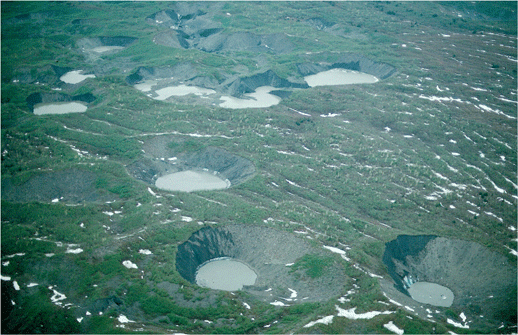kettle holes
Kettle, also called Kettle Hole, in geology, depression in a glacial outwash drift made by the melting of a detached mass of glacial ice that became wholly or partly buried. The occurrence of these stranded ice masses is thought to be the result of gradual accumulation of outwash atop the irregular glacier terminus. Kettles may range in size from 5 m (15 feet) to 13 km (8 miles) in diameter and up to 45 m in depth. When filled with water they are called kettle lakes. Most kettles are circular in shape because melting blocks of ice tend to become rounded; distorted or branching depressions may result from extremely irregular ice masses
https://www.britannica.com/science/kettle

http://www.landforms.eu/cairngorms/kettle%20hole.htm

By NASA image, created by Jesse Allen, Earth Observatory, using data obtained courtesy of the University of Maryland’s Global Land Cover Facility. - http://earthobservatory.nasa.gov/IOTD/view.php?id=6034, Public Domain, https://commons.wikimedia.org/w/index.php?curid=751529

North-looking oblique aerial photograph showing about a dozen enlarging depressions forming on the surface of debris-covered stagnant ice in the medial moraine band area of Bering Glacier's piedmont lobe, Chugach National Forest, Chugach Mountains, Alaska. The largest kettle shown is ~ 150 feet in diameter. Bering Glacier flows through Wrangell-Saint Elias National Park.
Alternative terms
- UF↸ kettle
Broader Terms
Related terms
- RT⇆ glacier recession
- RT⇆ outwash plain
- RT⇆ calving
- RT⇆ debris
- RT⇆ debris covered glacier
- RT⇆ glacier ice
- RT⇆ kame
- RT⇆ melt water
- RT⇆ morainic ridge
- RT⇆ terminal moraines
- RT⇆ till
- Italiano marmitte




